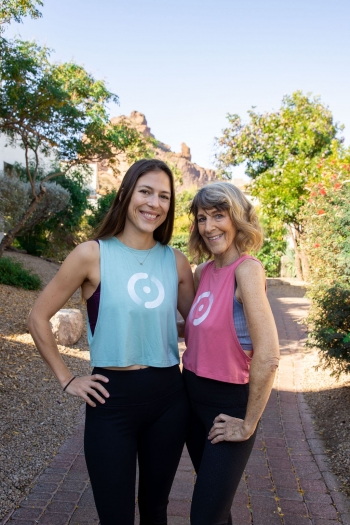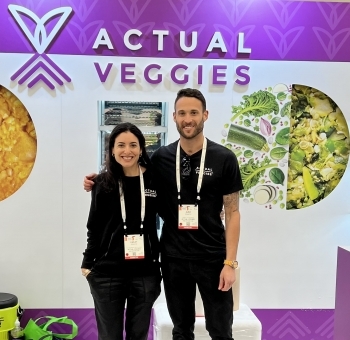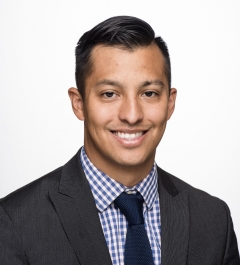
Herbert Roskind has met many students over the past decade while teaching the course Global Trade in Real Time at Arizona State University — and some of those students have shared his entrepreneurial spirit.
“Several of our former ASU students started businesses; one already succeeded nationally,” said Roskind, a courtesy affiliate and advisory board member in the School of Politics and Global Studies who uses his decades-worth of experience in entrepreneurship and commodity trading to teach students about supply chain management and negotiations while accounting for cultural differences.  ASU alum Sophie Aigner (left) and her mother, Vickie, co-founders of Alive, Fit & Free. Download Full Image
ASU alum Sophie Aigner (left) and her mother, Vickie, co-founders of Alive, Fit & Free. Download Full Image
“We’re proud of them, encouraging others to invent themselves.”
Sophie Aigner, who graduated with a Bachelor of Arts in global studies in 2012, originally took Roskind’s course as a way to see what a career in the global supply chain industry would look like.
“This course was very interesting as it was super practical and gave very clear insights into the careers of the shipping industry,” said Aigner. “Professor Roskind has a vast experience in global negotiations and shipping, so the biggest takeaways were learning from his practical experience.”
After graduating, Aigner worked in Africa before piloting the startup Lima Links, a Zambian agricultural technology company, in 2016. After four years, she was ready for a change and partnered with her mom, Vickie Aigner, to develop Alive, Fit & Free, which is a virtual community where people of any age around the world can participate in live experiences.
Throughout the years, Aigner has maintained a relationship with Roskind thanks to his mentorship.
“(Roskind) is an entrepreneur at heart and has great advice in many areas, so he is currently an advisor of mine in a startup I am working on,” Aigner said.

ASU alum Alex Swartz (right), co-founder of Actual Veggies.
ASU alum Alex Swartz (right), co-founder of Actual Veggies.
Alum Alex Swartz took Roskind’s class in 2012 while completing his Bachelor of Science in supply chain management. The course aligned with his interests in commodity trading and the markets.
“Knowing that (Roskind) worked in commodity trading starting in the mail room to one day starting his own firm,” Swartz said, was an inspiration for him to work in physical oil trading.
Now, 10 years later, Swartz is pursuing his passion of entrepreneurship through his brand Actual Veggies.
“My sister, a friend and I started a veggie burger company that manufactures and distributes whole-food veggie burgers that celebrate veggies instead of mask(ing) them,” said Swartz.
Swartz started Actual Veggies in March 2020. Aiming to create the best-tasting veggie burger using only real ingredients was no easy task — it took eight months to create the recipe. Thanks to investment help from Big Idea Ventures, Swartz was able to get his veggie burgers launched nationwide in Sprouts in July 2021 and partnered with big online retailers like Blue Apron, Hungryroots and Imperfect Foods.
“(Two and a half) years later, we are in almost 2,500 retail stores and learning from our mistakes,” said Swartz. “We are very proud of what we’ve accomplished but feel we are just getting started.”
It was also in 2012 when Eduardo R. Cervantez discovered Roskind’s class. He was attending ASU while pursuing a BA in sustainability and a minor in global studies. The class appealed to him since it was one of the few business-oriented classes within his areas of study.
ASU alum Eduardo R. Cervantez
The class provided him the opportunity to expand his comfort zone and helped develop his skills in negotiations — which Cervantez says is key in every aspect in life.
“I think everyone is intimidated about business, but this class is perfect to take because of the connections you make,” said Cervantez. “All the material you learn in the class can be applied in real life and in any situation.”
Cervantez works in finance as a vice president of capital forecasting, and he manages the capital projections for the Citigroup Bank in New York City.
“(Roskind) is a great professor, mentor and family friend,” said Cervantez. “… I have a tremendous amount of respect for how he has helped me in my life.”
Christopher Robin Gallego, who graduated with a film and media production degree from ASU in 2013, did not sign up for Roskind’s course but would end up learning from it anyway.
In 2011, following Harvard’s “flipped’ teaching concept, Roskind was looking to hire a student videographer to film his course. He hired Gallego for what would be his first paid job as a video producer.
“More than that, it was the beginning of my mentorship by Herb,” Gallego said.
According to Gallego, Roskind is a “titan of industry,” which helped make his unique course so attractive.
“So when Herb wants to do something like visit the Port of Long Beach to film some interviews for the video course, all he has to do is make a couple of phone calls and it’s done,” recalled Gallego.
The excursion through Southern California would lead to Gallego landing his first summer internship in Hollywood.
During the following fall, Gallego completed editing of the series of videos for Roskind’s course, but they weren’t up to the quality he was hoping for. Feeling like he let Roskind down, Gallego was crushed.
After graduation, he moved to LA and worked enough to invest in his own upgraded camera kit. The pair stayed in touch over the next couple of years, and when Roskind was in LA vising family, Gallego would get a chance for redemption. He offered to film Global Trade in Real Time free of charge, stating, “Don’t worry about it. I owe you one.”
Given that YouTube was the leading site in video learning, they created the “Global Trader Network” channel to host the videos.
In 2018, Gallego went full-time as an independent producer, ultimately getting hired as head of production for the streaming startup service MagicFlix in Las Vegas. However, the pandemic would ultimately alter his plans, and he moved back to Los Angeles.
Using his skills in web design and SEO, Gallego helped launch a lead-generation site with a friend in the construction business. They have run a seven-figure business ever since.
It was around this time Roskind reached out to propose working together again.
“I think we’re going to take the Global Trader Network to the next level,” said Gallego.
Manager of marketing and communications, School of Politics and Global Studies
480-727-9901 mo*****@*su.edu
Arizona State University astronomers are sharing one of their first and most beautiful NASA James Webb Space Telescope images of a galaxy pair at a distance of about 700 million light-years away from us.Using Webb’s new images and data, the scientists were able to trace the light that was emitted by the bright white elliptical galaxy through the winding spiral galaxy in front of it, allowing a…
Arizona State University astronomers are sharing one of their first and most beautiful NASA James Webb Space Telescope images of a galaxy pair at a distance of about 700 million light-years away from us.
Using Webb’s new images and data, the scientists were able to trace the light that was emitted by the bright white elliptical galaxy through the winding spiral galaxy in front of it, allowing astronomers to identify the effects of interstellar dust in the spiral galaxy.
Webb interdisciplinary scientist and ASU Regents Professor Rogier Windhorst and his teamASU undergraduate student Jake Summers performed the pipeline data reduction. The dust analysis was led by William Keel of the University of Alabama, while the Hubble data acquisition was led by Benne Holwerda of the University of Louisville in Kentucky. The detailed gravitational-lensing analysis was conducted by Giovanni Ferrami and Stuart Wyithe, both of the University of Melbourne, Australia. obtained the data used in these images from early results of the telescope’s Prime Extragalactic Areas for Reionization and Lensing Science (PEARLS) project.
“This is a rather unique opportunity to measure how much dust has been produced in this spiral galaxy, like our own, by previous generations of stars. Mind you that this is the kind of dust that the next generation of stars and planets, and in our case people, are also formed from,” Windhorst said.
Webb scientists are now able to delineate how star formation can happen in these kinds of galaxies from the gas and the dust that formed in the past. They folded in Hubble images to provide some of the bluish light, but almost all of this light is coming from Webb.
The Webb images used for this study observe wavelengths longer than those visible to the naked eye, but they are mapped onto our familiar family of colors to make our images. They are combined with Hubble data observing visible light to accurately model both the original light from the background elliptical galaxy, and how much it was reddened by the foreground spiral.
A sunset at the horizon, for example in Arizona, appears red because of dust in the atmosphere, and because our atmosphere transmits red light better than the blue light. The same principle applies in the Webb images.
The infrared light that Webb observes from the elliptical galaxy is very well visible in the images, even when passing through the dust of the foreground spiral. Windhorst says that most of this light is rendered as false color. You’re not actually looking at blue or violet light, but at near-infrared light that has been rendered for the eye to see.
Above the white elliptical galaxy at left, a faint red arc appears in the inset at 10 o’clock. This is a very distant galaxy whose appearance is warped. Its light is bent by the gravity of the elliptical foreground galaxy. Plus, its appearance is duplicated. The stretched red arc is warped where it reappears — as a dot — at 4 o’clock. In this image, green, yellow and red were assigned to Webb’s near-infrared data taken in 0.9, 1.5 and 3.56 microns. Blue was assigned to two Hubble filters, ultraviolet data taken in 0.34 microns and visible light in 0.61 microns. Credit: NASA, ESA, CSA, Rogier Windhorst (ASU), William Keel (University of Alabama), Stuart Wyithe JWST PEARLS Team
Webb’s technology allows for a better visualization of the attenuation by dust that Hubble was not able to do. Webb’s eight new infrared filters allow for a more accurate analysis when mapping the attenuation by dust.
Windhorst explained that by comparing images of Hubble and Webb, the dust lanes in the foreground spiral become visible, the same dust that our solar system is made from when it formed our sun and its planets.
This dust now becomes visible because that background elliptical galaxy acts like a flashlight. It is the dust attenuation in this spiral galaxy that Windhorst and his team are trying to map, and it can be traced very well with the new Webb infrared images.
The Windhorst group combined data from Hubble and Webb to get some other surprising results. The image and data showed not only this a rather unique alignment of an elliptical in the background and a spiral galaxy they were trying to measure in the foreground, but they saw a strange-looking arc-shaped object behind the elliptical galaxy.
This is a distant galaxy seen within the first few billion years after the Big Bang. Its light was gravitationally distorted by the enormous mass of the elliptical galaxy, which is close to the mass of a hundred billion suns. And the very large mass of the elliptical galaxy stretches the very distant small galaxy into an arc.
The light from that distant galaxy is in reality almost directly behind the center of the elliptical, but its light comes around via two gravitationally bent paths: One is a stretched arc-like image, and the other is a faint counterimage on the other side of the elliptical galaxy center.
“We got more than we bargained for by combining data from NASA’s James Webb Space Telescope and NASA’s Hubble Space Telescope,” Windhorst said. “Webb’s new data allowed us to trace the light that was emitted by the bright white elliptical galaxy, at left, through the winding spiral galaxy at right — and identify the effects of interstellar dust in the spiral galaxy.”
Video by Steve Filmer/ASU Media Relations
The scientific paper was submitted recently to The Astrophysical Journal. The research has also allowed ASU-NASA Space Grant intern Jake Summers to be part of the working for the ASU Cosmology Research Group as part of the Webb Telescope PEARLS team.
“I find it astonishing how Webb can provide for completely unexpected findings, such as the lensed galaxy behind the elliptical galaxy in the VV191 system, with relative ease and with only half an hour of exposure time,” Summers said. “The resolution of Webb never ceases to amaze me — I was blown away by the fact that it can resolve individual globular clusters in the main elliptical galaxy.”
William Keel of the University of Alabama is the lead author of this study, with co-authors including Windhorst, and Seth Cohen and Rolf Jansen from the School of Earth and Space Exploration.
The VV191 galaxy pair was called to the attention of researchers by citizen science group Galaxy Zoo. Keel has been involved Galaxy Zoo for nearly 15 years and was initially drawn to the group for the ability of participants to pick out rare galaxy types, especially silhouetted or overlapping galaxy systems.
“VV191 is the latest addition to a small number of galaxies that helps researchers like us directly compare the properties of galactic dust,” Keel said. “This target was selected from nearly 2,000 superimposed galaxy pairs identified by Galaxy Zoo citizen science volunteers.”
The James Webb Space Telescope is the world’s premier space science observatory and was launched in December 2021. Webb will solve mysteries in our solar system, look beyond distant worlds around other stars and probe the mysterious structures and origins of our universe and our place in it. Webb is an international program led by NASA with its partners, the European Space Agency and the Canadian Space Agency.
Second-year astrophysics and math student Jake Summers (left) looks on as research scientist Seth Cohen and Regents Professor Rogier Windhorst examine a new image from the Webb telescope in Windhorst’s lab.
Research scientist Seth Cohen talks during a Zoom meeting. Students, staff and faculty had gathered in the lab to analyze data and images coming in from the new James Webb Space Telescope, the older Hubble Space Telescope as well as ground-based telescopes based around the globe.
Top image: Researchers traced light that was emitted by the bright white elliptical galaxy on the left through the spiral galaxy at right. As a result, they were able to identify the effects of interstellar dust in the spiral galaxy. Webb’s near-infrared data also shows us the galaxy’s longer, extremely dusty spiral arms in far more detail, giving them an appearance of overlapping with the central bulge of the bright white elliptical galaxy on the left, though the pair are not interacting. In this image, green, yellow and red were assigned to Webb’s near-infrared data taken in 0.9, 1.5 and 3.56 microns. Blue was assigned to two Hubble filters, ultraviolet data taken in 0.34 microns and visible light in 0.61 microns. Credit: NASA, ESA, CSA, Rogier Windhorst (ASU), William Keel (University of Alabama), Stuart Wyithe (University of Melbourne), JWST PEARLS Team
Alumni and Special Events Coordinator , School of Earth & Space Exploration
480-727-4662 Ki**********@*su.edu
Contact us










